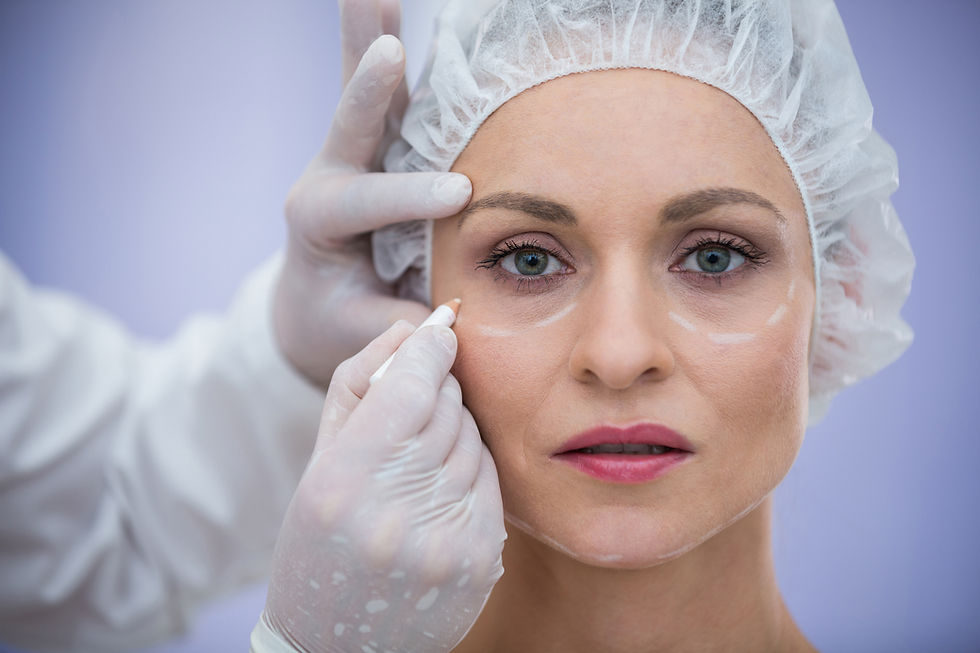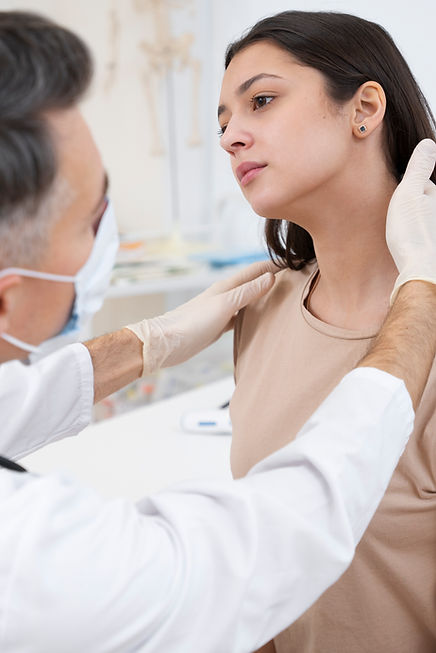_edited.jpg)
Face Lift
A facelift, or rhytidectomy, is a cosmetic surgery to refresh your appearance by improving deep folds from the nose to the mouth, tightening jowls, and redefining the jawline and cheekbones. It also addresses loose neck skin and the "turkey gobbler" look by removing excess fat and tightening muscles. Typically, individuals over 40 consider this, though some younger patients may benefit. Incisions are discreetly hidden around the ears or under the chin. The procedure, lasting 2-4 hours, repositions deeper tissues and removes excess skin for a natural, rejuvenated look, often performed as an outpatient procedure.
Lip Reduction
Lip reduction surgery, or reduction cheiloplasty, offers a significant benefit to patients who feel their lips are disproportionately large, helping them achieve a more balanced and harmonious facial appearance. It can also improve comfort for those whose excessively full lips interfere with speaking or eating. The procedure is typically performed by making precise, hidden incisions on the inside of the lip to carefully remove excess tissue, allowing the lips to be reshaped to a more desired and aesthetically pleasing size. This sculpting creates a refined contour that complements other facial features, enhancing overall self-confidence.


Eyelid Correction
Eyelid correction surgery, known as blepharoplasty, offers a significant improvement for individuals with tired-looking eyes due to sagging skin and puffy bags. This procedure can profoundly help patients by restoring a more alert, refreshed, and youthful appearance, and in some cases, even improve peripheral vision if drooping upper lids were obstructing it. The process involves carefully making small incisions, often hidden within the natural creases of the eyelids or inside the lower lid, to remove excess skin, muscle, or fat. This precise sculpting allows for the redraping of the remaining skin, resulting in smoother, firmer eyelids that beautifully frame the eyes.
Rhinoplasty
Rhinoplasty, commonly known as a "nose job," is a surgical procedure that can significantly enhance a patient's facial harmony and improve breathing function. For many, it helps achieve a more aesthetically pleasing nose that better complements their other features, boosting self-confidence and overall well-being. Additionally, rhinoplasty can correct structural issues within the nose, such as a deviated septum, enabling easier and more efficient breathing. The procedure involves carefully reshaping the bone and cartilage of the nose through precise incisions, which are often hidden inside the nostrils or across the narrow strip of skin between them. This allows the surgeon to reduce or increase size, alter the tip or bridge, narrow the nostrils, or change the angle of the nose for a balanced and natural result.
.jpg)
Fat Grafting
Fat grafting offers a natural solution for facial rejuvenation and body contouring by transferring your own fat to enhance volume and shape. This two-step procedure involves gentle liposuction to harvest fat from areas like the abdomen or thighs, which is then purified and strategically injected into target areas such as the cheeks, lips, or under-eye hollows. Results appear gradually as the fat integrates, with long-lasting, natural-looking outcomes. While some fat may be reabsorbed, skilled surgeons optimize survival rates through advanced techniques. Ideal for those seeking both fat reduction and volume restoration, fat grafting provides dual benefits with minimal risk of rejection. Recovery involves mild swelling, with final results visible within months.

.jpg)
Earlobe Removal
Earlobe reduction or repair is a simple cosmetic procedure to reshape stretched, torn, or oversized earlobes—often caused by heavy earrings, gauges, or aging. Performed under local anesthesia, the surgeon trims excess tissue and sutures the lobe for a natural, proportional appearance. The quick outpatient procedure takes about 30 minutes, with minimal downtime (stitches removed in 5–7 days). Scarring is discreet, and patients can repierce ears after healing. Ideal for restoring torn lobes post-trauma or achieving subtle aesthetic refinement. Results are immediate and permanent, with care instructions to prevent future stretching.
Buccal Fat Removal
Buccal fat removal is a cosmetic procedure that slims the lower face by surgically removing excess fat pads from the cheeks. Ideal for those with naturally round or "chubby" faces, this outpatient surgery creates a more sculpted, contoured appearance. Performed through small incisions inside the mouth (leaving no visible scars), the 30-60 minute procedure requires local or general anesthesia. Recovery involves mild swelling and discomfort for about a week, with final results visible as swelling subsides over 2-3 months. While results are permanent, candidates should be over 25, as buccal fat naturally diminishes with age. Not recommended for those with already lean faces, as over-removal can cause premature aging

FAQs
Good candidates for facial plastic surgery are healthy individuals with realistic expectations about outcomes. Ideal patients are non-smokers (or willing to quit before surgery), have no uncontrolled medical conditions, and seek improvement—not perfection—in their appearance. A consultation with a qualified surgeon assesses skin quality, bone structure, and aesthetic goals. Younger patients may opt for minor enhancements (e.g., chin implants), while older patients might choose facelifts to address sagging skin. Psychological readiness is crucial—patients should pursue surgery for themselves, not external pressure. The surgeon evaluates medical history, discusses risks, and determines suitability before proceeding.
Select a board-certified facial plastic surgeon (American Board of Facial Plastic and Reconstructive Surgery or equivalent). Review before-and-after photos, read patient testimonials, and verify credentials. During consultations, assess their communication style, willingness to answer questions, and surgical approach. Avoid "discount" providers—experience and safety matter more than cost. A trustworthy surgeon prioritizes natural-looking results and patient well-being over aggressive alterations.
Recovery varies by procedure but generally involves swelling, bruising, and discomfort for the first 1–2 weeks. Rhinoplasty may require a nasal splint for a week, while facelift patients often wear compression garments. Most patients resume light activities within 7–10 days but avoid strenuous exercise for 4–6 weeks. Pain is manageable with prescribed medications, and cold compresses help reduce swelling. Strict adherence to post-op care—such as keeping incisions clean and avoiding sun exposure—ensures proper healing. Final results emerge over several months as swelling subsides. Non-surgical treatments (e.g., fillers) have minimal downtime, with minor redness or swelling resolving in days. Follow-up visits monitor progress, and surgeons provide personalized recovery guidelines.
While generally safe, facial plastic surgery carries risks like infection, bleeding, scarring, or anesthesia reactions. Poor wound healing, nerve damage (temporary numbness), or asymmetry may occur. In rhinoplasty, breathing difficulties or dissatisfaction with cosmetic results are possible. Choosing an experienced, board-certified surgeon minimizes risks. Pre-operative health screenings and following pre/post-op instructions (e.g., avoiding smoking) reduce complications. Non-surgical treatments have fewer risks but may cause allergic reactions or lumps if improperly administered. Realistic expectations and open communication with the surgeon help mitigate concerns. Most complications are rare and treatable when detected early.
Surgical results are long-lasting but don’t halt natural aging. Facelifts typically last 7–10 years, while rhinoplasty and eyelid surgery provide permanent structural changes—though aging may alter appearance over time. Non-surgical treatments (Botox, fillers) last 3–18 months, requiring maintenance. Healthy lifestyle choices (sun protection, no smoking, skincare) prolong results. Some patients opt for minor touch-ups later. Surgeons discuss longevity during consultations, emphasizing that while surgery turns back the clock, ongoing care ensures sustained outcomes.
